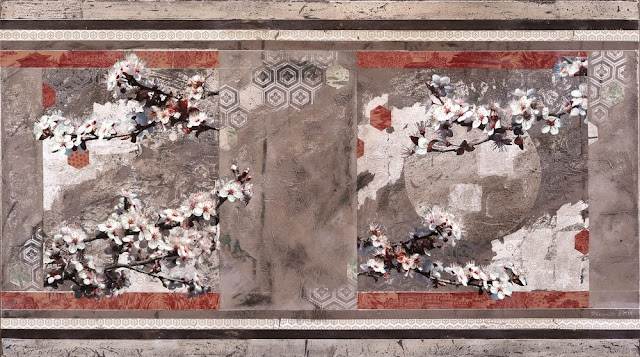As mentioned in my last post, ‘Karisome – Transience’ is running at Yering Station until May 17th so there's still heaps of time to pop out for a look,and possibly a taste of the beautiful wine on offer, if you're in the vicinity. I have just finished a short video interview about the background to the exhibition title and paintings so you can get a sense of what is on show. (click on the video below to view)
Karisome Video Interview on YouTube
May I extend an enormous thank you to everyone who made out to Yering Station for the exhibition opening and a huge thank you also to both Jeanette Davison and Ewan Jarvis for their heartfelt, eloquent and insightful speeches.
Here is an excerpt from Ewan Jarvis's wonderful speech...... with some images of paintings in the show nestled between his words. An enormous thank you again Ewan xxxx
Beneath the Blossom 84cm x 152cm, 2015
"Good evening and welcome to the Yering Station Gallery. My name is Ewen Jarvis. I run the cellar door here at Yering Station and will be standing in for our curator Savaad Felich while he is on leave. So on his behalf and on behalf of the Yering Station Gallery, I’m delighted to be welcoming you to the opening of Nerina Lascelles’ exhibition ‘Karisome’ or ‘Transience’: a collection of works that take as their subject the transient nature of all things and the beauty inherent in transience itself.
The Japanese word Karisome denotes the inevitable dissolution of all form through the passage of time. Karisome can be translated into English as transient or temporary. Translation is however something of a haphazard affair, and these English words don’t quite convey the nuanced meaning of the Japanese word.
Maigure-shon - Migration 84cm x 152cm, 2015
Now yesterday, with all of this in mind, I decided to ask a few Japanese visitors to the gallery for their personal definition of Karisome. My favourite response was from a lady called Michiko from Kobe, who was on holiday with her mother and grandmother. Michiko said that Karisome is ‘like a love affair that is all the more moving and beautiful for being short’.
The chrysanthemum flowers, cherry blossoms, honey bees and migrating cranes of this exhibition ask us to reflect on love affairs that are all the more beautiful for being short, and in doing so they induce a Zen-like calm.
Karisome III 2 84cm x 152cm, 2015
Shihyou – Pattern, 122cm x 122cm, 2015
In Nerina’s works the layering of Japanese Kimono embroidery, Chinese silk, Washi paper, Joss and encaustic wax invites the viewer to step through the textured surface into imagined worlds, while the disparate vintages of the carefully chosen material invite us to become lost in the passing of time. Viewing these works, we are often jointly aware of the eternal and the transient. For example, in Japanese mythology the crane lives for 1,000 years, but for a human observer the spectacle of its migration is all the more beautiful for being fleeting.
Another element of Nerina’s exhibition that endears me to her work are the titles taken from the Japanese poetry. I always enjoy an exhibition a little more if the titles of the works are working as hard as the works themselves. Nerina certainly doesn’t disappoint. Take for instance the title of the following piece:
The sun covered
By clouds for a while
Migrating birds
Basho 1644-1694
For me, haiku like this has the effect of someone walking into a room and playing a few exquisite notes on a flute and then leaving.
These words, written in seventeenth century feudal Japan by Matsuo Basho (and for those of you unfamiliar with Matsuo Basho, he is the Japanese equivalent of Shakespeare) these words introduce us to a work in which migrating-silk-kimono cranes are seen traversing an airy skyscape of precipitous paper mountains, gold gilt clouds, crooked trees clinging to crevasses, while delicately penned Japanese words fall like rain into low valleys.
The overall effect is of entering a tranquil, complex and dreamlike space....."
Photos thanks to Kerry Cross
"Karisome - Transience" Runs April 2 - 17 May 2015
Opening Drinks Friday April 10th 6pm - 7.45
Admission Free
Contact details:
Contact details:
Exhibition Coordinator - Savaad Felich
artgallery@yering.com
T 03 9730 0102









.jpg)

